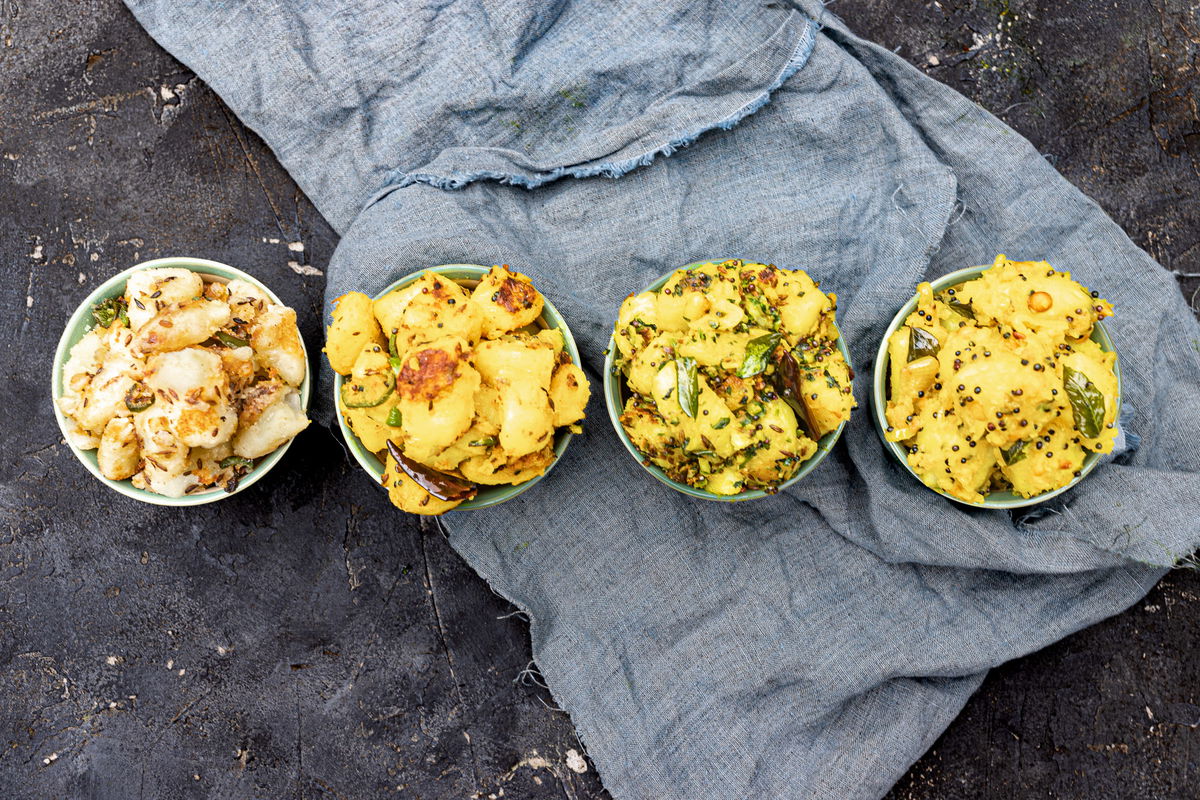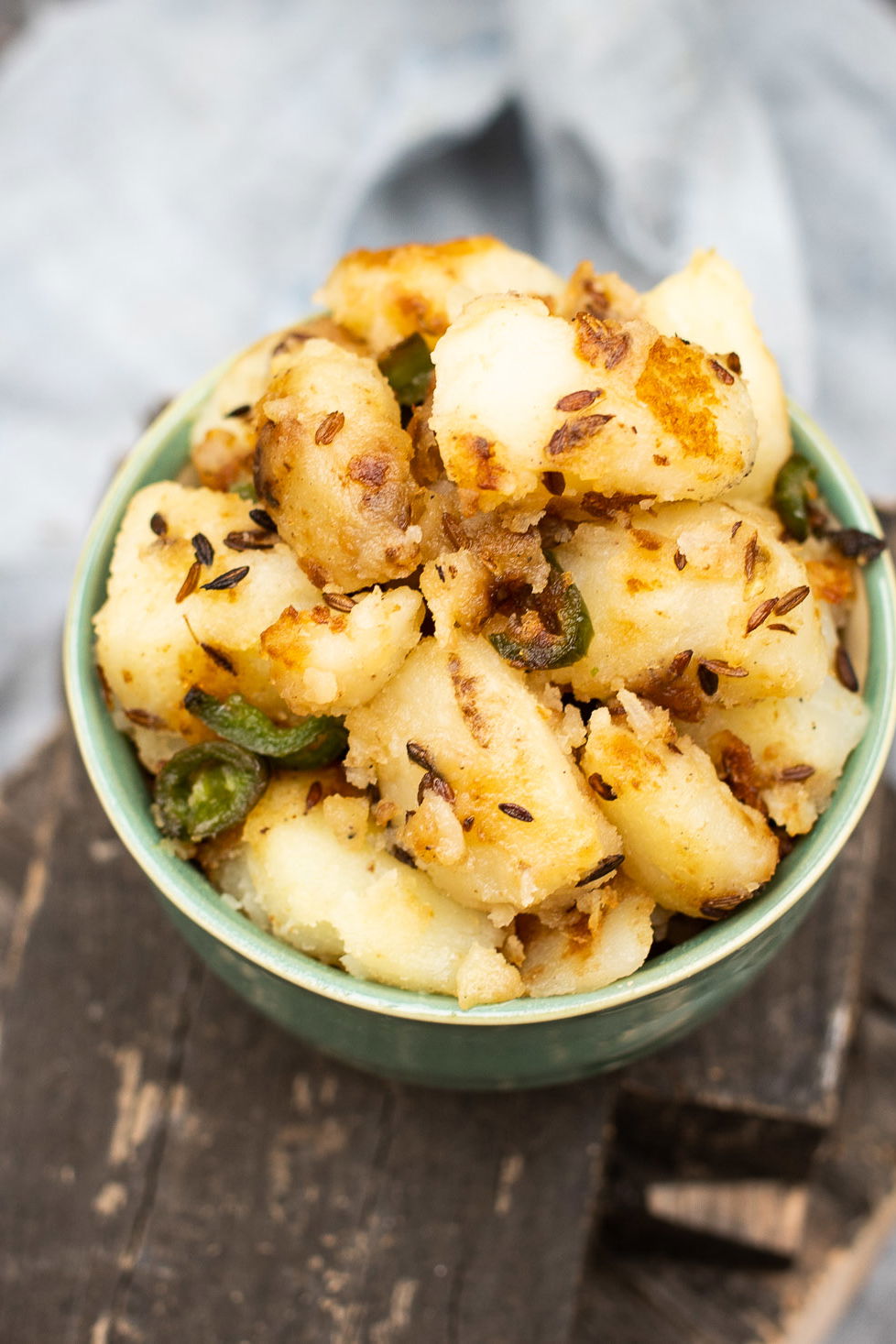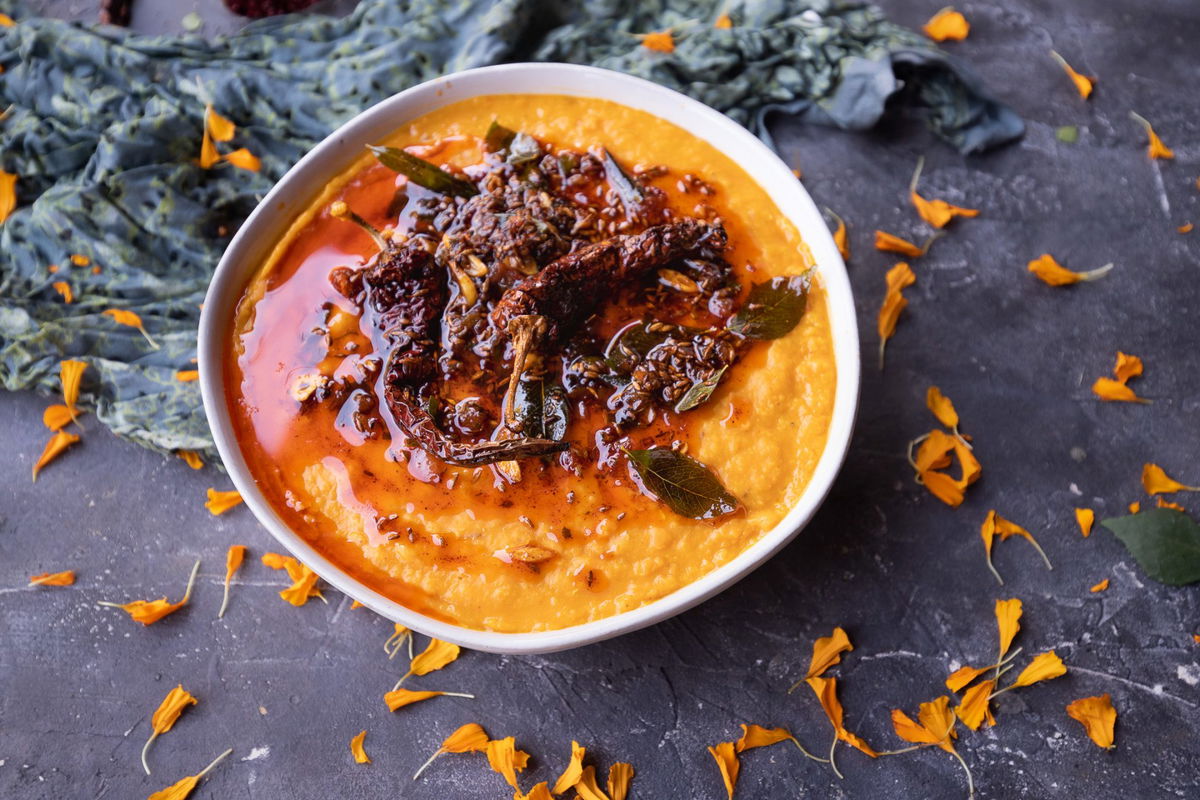Vaghar is like a microcosm of Indian cooking. A proper vaghar is a balance of many flavors, which makes sense because it is one of the most powerful ways to add flavor to your dish. Vaghar adds:
- Richness: the oil (preferably ghee) add a richness to your dish
- Flavor: Spices like chili, garlic, onion, and curry leaves, add depth of flavor and heat
- Aroma: Blooming your spices in full fat releases their aromas
- Color and Texture: Vaghars introduce additional color and texture to your dish
There’s something I do in all of my posts on this blog that I always feel a little guilty about. I’ve never been completely comfortable with it, it almost feels dishonest, but it’s necessary and there seems to be no way to avoid it. That is, I provide measurements.
I don’t like doing it because it’s just not how Indians cook. Indian cooking is much more approximate, intuitive and based on personal taste and experience. To me, that is where the joy comes from. My mother, my aunt and my grandmother all cooked the same dishes, but they all taste different.

If you want to learn to cook this way, one of the fundamental techniques you will want to learn is Vaghar. Vaghar is one of the most fundamental Indian cooking techniques. “Vaghar” is what my Gujarati family calls it, but every region has their own name for it, like Tadka, choonk or baghaar.
Vaghar is a technique of pan frying spices before adding them to your dish. In English this would be called “tempering.” The frying of the spices toasts them and really brings out the aromatics. A vaghar is a mix of spices prepared in this way. Knowing what spices to use and how to vaghar is once of the most basic skills of Indian cooking.
When you understand vaghar, you can easily go into your pantry or refrigerator, find a few ingredients and create your own Indian dish, you won’t even need a recipe.
Ayurvedics would also say vaghar opens up the spices, improving their nutritional and medicinal value when consumed.
Names for Vaghar
| Nepali | Jhaneko, jhannu |
| Hindi | Chaaunk, tarka, tadka, bagar, choonk |
| Punjabi | Tarka, tadka |
| Gujarati | Vaghar |
| Bengali | Bagar, bagar dewa, phoron, baghaar |
| Tamil | Thaalithal |
| Kannada | oggarane |
| Telugu | Popul, thiragamaatha, taalimpu |
| Marathi | Phodani, pholni |
| Urdu | Tarka, baghar |
| Konkani | Phonna |
Types of Vaghar
Like most things in Indian cooking, vaghars vary by region, and even household. Additionally, you will want to use specific ingredients in your vaghar based around what you are cooking. For example, hing (asafoetida) is sure to be included in any vaghar that will be used on beans. That is because in addition to being a flavor enhancer, hing is a digestive aid. It helps prevent gas.
Kerala
Kerala, a mix of coconut, cinnamon stick, star anise, and clove is popular
Punjabi
Punjabis combine cardamom pods, cinnamon stick, clove, ginger, garlic, and onion
Bengali
Bengali cooks enjoy black mustard seed, cumin seed, nigella seed, and fenugreek seed
Gujarati
Gujaratis use black mustard, cumin, asafoetida, …
- Fresh green bean (papdi, long bean, green bean): use carom seed instead of cumin
- Root vegetables, cauliflower, zucchini (anything mild): use cumin or cumina and mustard as the main ingredient
- Dal: add hing; cumin or cumin and mustard; you can also add curry leaves; cinnamon or clove, optionally garlic
- Kadhi (yogurt): cumin, clove and sometimes garlic
- Dokhra and Handvo: add sesame seeds and mustard seeds, which adds a visual appeal to the top of the steamed bread
Ingredients to Choose From:
- Coriander
- Cumin
- Fennel
- Fenugreek
- Nigella
- Sesame Seeds
- Mustard seeds
- Green and Black Cardamom
- Turmeric
- Lentils, split-peas, hulled urad dal (dry, uncooked)
- Asafetida
- Onions and shallots
- Ginger
- Chilies (fresh or dried)
- Curry Leaves
- Bay Leaves (Indian Bay Leaves if you have them)
- Garlic
How to Make It
There are a couple of factors to keep in mind when making Vaghar. If you are making a vaghar with multiple ingredients you will need to get your timing right. The slow cooking ingredients will go in first, while the fast cooking ingredients will have to be saved for the end. Timing is everything!
Another thing to keep in mind is your pan. When making a small vaghar, you can get away with toasting your ingredients in a shallow pan, but when you need a lot of vaghar you want something deep. That is because it tends to splatter, especially if you are adding soft ingredients like onion and cilantro. And some ingredients, like mustard seeds, want to jump around when they get hot.
I have a special “vaghar” pan I use for just for making vaghar. It’s not requires, but it has the right shape to make things easy. In the video I used a skillet because I wanted to show that it can be made with regular household equipment. You can also make it directly in a pot, the large sides will help contain the splattering.
When Is Vaghar Added to Dish?
Most dishes start with a vaghar, especially vegetables.
Liquid dishes like kadhi and dal, either do a vaghar at the end or do a double vaghar. By topping it off with a vaghar you add a little visual interest.
What kind of oil should be used?
Traditionally Gujaratis would use ghee, or peanut oil. Ghee is clarified butter which helps raise its smoke point which is very important for vaghar. Vaghar needs to take place in very hot oil.
Most vegetable oils will work in place of ghee. South Indians might commonly use coconut oil. Mustard oil is commonly used in North and East India. Coconut and mustard oil can handle high heat, but they are not neutral and will impart their own flavors. You can choose to use a neutral oil like Grapeseed oil, which can handle high heat. Avoid lower heat oils like olive oil.
What Spices Should I Use?
Technically, any spice will work. For a simple meal, I keep it very simple with just cumin and oil. For more complexity, I would pick out a combination from a regions cuisine. Those have been worked out by generations of Indian cooks and proved themselves over time. From there, I would not hesitate to experiment by making my own substitutions or additions.
In the video, I make 4 different versions of potatoes. The vaghars I used are vegetable vaghars. I would use them for any vegetable shaak.
Simple Vaghar
This is a very simple vaghar with only two spices, cumin and mustard seed

Ingredients
- 1 tbsp ghee
- 1/2 tsp cumin seeds
- 1/2 tsp mustard seeds
- 2 cups cooked potatoes or other vegetable, chopped
Instructions
- Heat the oil in a pan over medium-high heat
- Add cumin and mustard seeds
- Allow to fry until they begin to brown and aroma becomes strong
- Mix in cooked potatoes or other vegetables, allowing them to cook a little bit so the flavors get integrated.
Video
Simple Vaghar
This is a very simple vaghar with only two spices, cumin and mustard seed

Ingredients
- 1 tbsp ghee
- 1/2 tsp cumin seeds
- 1/2 tsp mustard seeds
- 2 cups cooked potatoes or other vegetable, chopped
Instructions
- Heat the oil in a pan over medium-high heat
- Add cumin and mustard seeds
- Allow to fry until they begin to brown and aroma becomes strong
- Mix in cooked potatoes or other vegetables, allowing them to cook a little bit so the flavors get integrated.
Video
Simple Vaghar
This is a very simple vaghar with only two spices, cumin and mustard seed

Ingredients
- 1 tbsp ghee
- 1/2 tsp cumin seeds
- 1/2 tsp mustard seeds
- 2 cups cooked potatoes or other vegetable, chopped
Instructions
- Heat the oil in a pan over medium-high heat
- Add cumin and mustard seeds
- Allow to fry until they begin to brown and aroma becomes strong
- Mix in cooked potatoes or other vegetables, allowing them to cook a little bit so the flavors get integrated.
Video
Simple Vaghar
This is a very simple vaghar with only two spices, cumin and mustard seed

Ingredients
- 1 tbsp ghee
- 1/2 tsp cumin seeds
- 1/2 tsp mustard seeds
- 2 cups cooked potatoes or other vegetable, chopped
Instructions
- Heat the oil in a pan over medium-high heat
- Add cumin and mustard seeds
- Allow to fry until they begin to brown and aroma becomes strong
- Mix in cooked potatoes or other vegetables, allowing them to cook a little bit so the flavors get integrated.
